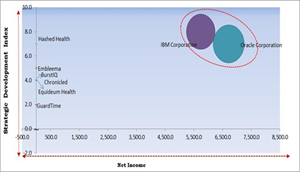With, among others, IBM, Oracle, Hashed Health and Emblemema

blockchain-technology-in-healthcare-market-competition-analysis.jpg

Dublin, Jan. 10, 2023 (GLOBE NEWSWIRE) — “Global Blockchain Technology in Healthcare Market Size, Share & Industry Trends Analysis Report By End User, By Type, By Application (Supply Chain Management, Data Exchange & Interoperability, Claims Adjudication) & Billing ), By Regional Outlook and Forecast, 2022 – 2028” report has been added ResearchAndMarkets.com’s Offering.
The size of the global blockchain technology in the healthcare sector is expected to reach USD 5.3 billion by 2028, increasing at a market growth rate of 39.9% CAGR during the forecast period.
A blockchain refers to a shared distributed database or ledger between computer network nodes. A blockchain also acts as a digital database for storing data. The blockchain consists of blocks with a special storage capacity that, when filled, are closed and connected to the block that preceded them to form a data chain. When the chain is complete, a new block is created from each bit of information that follows the bare block and added to the chain.
A blockchain network is used in the healthcare sector to collect and access patient data across hospitals, diagnostic laboratories, pharmaceutical companies and doctors. It can improve the efficiency, security and transparency of medical data exchange throughout the healthcare system. By using this technology, medical institutions can gain knowledge and improve the evaluation of patient data. One of the key factors affecting the deployment of blockchain technology in the healthcare sector is the increase in data breaches.
The adoption of blockchain technology in healthcare has increased the demand for blockchain technology in the sector. It can result in significant annual cost savings in areas such as IT, personnel, operations and support function expenses as well as reductions in fraud and the sale of counterfeit goods. Complete protection against fraudulent drugs can be provided by incorporating blockchain with supply chain management, making it the most popular blockchain technology in the healthcare sector.
The health sector has a very serious problem: pharmaceutical counterfeiting. The lack of transparency in pharmaceutical supply chains makes it easy for fraud and manipulation. As blockchain technology enables system clarity and data integrity, it provides ideal solutions to combat pharmaceutical counterfeiting. It provides total, end-to-end supply chain transparency.
COVID-19 impact assessment
The lockout caused delays in the production and delivery of critical medical supplies. Limited access to medical care, staffing shortages in the healthcare sector, and an increase in COVID-19-related hospitalizations are a few more variables impacting the market.
The coronavirus outbreak accelerated the use of cutting-edge technologies in the healthcare sector, such as blockchain. Blockchain technology has been used by health services in a number of countries, improving efficient resource and operational planning. Several market players are creating a tracking system based on blockchain to stop the spread of incorrect information.
Market growth factors
Increasing need for improved communication between healthcare professionals and patients
Regardless of what an industry stands for, miscommunication is a mistake that has a detrimental effect on it. As people’s lives are at stake, it is particularly important to guarantee smooth and effective communication in the sensitive health sector. Communication breakdowns between healthcare professionals or between patients and providers can be very costly and even dangerous for the patient’s health.
The majority of miscommunications are caused by incomplete or inaccurate medical data, as it takes a long time to update them. Blockchain technology can be a useful remedy for this problem. Decentralized blockchain solutions exist. As a result, the information is held on different network nodes instead of just one database.
Increasing requirements for the storage and securing of medical data
Medical data storage and security requirements have increased, which can be beneficial for medical personnel, patients and healthcare facilities. Medical data can be kept secure thanks to blockchain technology’s cross-checking, encryption and decentralization, which is stimulating the market’s growth.
The digitization of the healthcare system and related business sectors is prioritized by the governments of various nations because, among other things, it has the potential to increase patient participation, improve health outcomes and make better forecasts.
Market limiting factors
Complexities that healthcare companies face during implementation
When it comes to how different institutions manage medical records, healthcare providers and insurance payers vary widely. Getting all these organizations to use blockchain technology without a streamlined, single-payer approach is expected to be very challenging. However, the effectiveness of the whole system is reduced if some people are not willing to adopt it. Therefore, convincing them to switch from paper medical records to electronic health records (EHRs) using blockchain is a difficult request. For example, doctors often leave questions blank since it is mandated by the technology.
Key topics covered:
Chapter 1. Market scope and methodology
Chapter 2. Market overview
2.1 Introduction
2.1.1 Overview
2.1.1.1 Market composition and scenario
2.2 Key factors influencing the market
2.2.1 Market drivers
2.2.2 Market Restrictions
Chapter 3. Competitive analysis – Global
3.1 Cardinal matrix
3.2 Recent industry-wide strategic developments
3.2.1 Partnership, collaboration and agreements
3.2.2 Product launches and product extensions
3.3 Top winning strategies
3.3.1 Key Leading Strategies: Percentage Distribution (2018–2022)
3.3.2 Key Strategic Move: (Partnerships, Collaborations and Agreements: 2018, February – 2022, August) Leading Players
Chapter 4. Global Blockchain Technology in Healthcare by End User
4.1 Global Pharmaceutical and Medical Devices Market by Region
4.2 Global Healthcare Payers Market by Region
4.3 Global market for healthcare services by region
Chapter 5. Global Blockchain Technology in Healthcare by Type
5.1 Global public market by region
5.2 Global private market by region
Chapter 6. Global Blockchain Technology in Healthcare by Application
6.1 Global Supply Chain Management Market by Region
6.2 Global Data Exchange and Interoperability Market by Region
6.3 Global claims adjudication and billing market by region
6.4 Global other market by region
Chapter 7. Global blockchain technology in the healthcare sector by region
Chapter 8. Company profiles
8.1 IBM Corporation
8.1.1 Company overview
8.1.2 Financial analysis
8.1.3 Regional and segmental analysis
8.1.4 Research and development costs
8.1.5 Recent strategies and developments:
8.1.5.1 Partnerships, collaborations and agreements:
8.1.5.2 Product launches and product extensions:
8.1.6 SWOT analysis
8.2 Oracle Corporation
8.2.1 Company overview
8.2.2 Financial analysis
8.2.3 Segmental and regional analysis
8.2.4 Research and development costs
8.2.5 Recent strategies and developments:
8.2.5.1 Partnerships, collaborations and agreements:
8.2.5.2 Product launches and product extensions:
8.2.6 SWOT analysis
8.3 Hashed health
8.3.1 Company overview
8.3.2 Recent strategies and developments:
8.3.2.1 Partnerships, collaborations and agreements:
8.3.2.2 Product launches and product extensions:
8.4 Emblem
8.4.1 Company overview
8.4.2 Recent strategies and developments:
8.4.2.1 Partnership, collaboration and agreements:
8.4.2.2 Product launches and product extensions:
8.5 Chronic
8.5.1 Company overview
8.5.2 Recent strategies and developments:
8.5.2.1 Partnerships, collaborations and agreements:
8.6 Equideum Health (ConsenSys Mesh)
8.6.1 Company overview
8.6.2 Recent strategies and developments:
8.6.2.1 Partnership, collaboration and agreements:
8.7 BurstIQ, LLC
8.7.1 Company overview
8.7.2 Recent strategies and developments:
8.7.2.1 Partnerships, collaborations and agreements:
8.8 Duty hours
8.8.1 Company overview
8.8.2 Recent strategies and developments:
8.8.2.1 Partnership, collaboration and agreements:
8.9 PharmaTrust
8.9.1 Company overview
8.1 Avaneer Health, Inc.
8.10.1 Company overview
For more information on this report, visit https://www.researchandmarkets.com/r/48g7hv
Attachments
CONTACT: CONTACT: ResearchAndMarkets.com Laura Wood,Senior Press Manager press@researchandmarkets.com For E.S.T Office Hours Call 1-917-300-0470 For U.S./ CAN Toll Free Call 1-800-526-8630 For GMT Office Hours Call +353-1-416-8900



